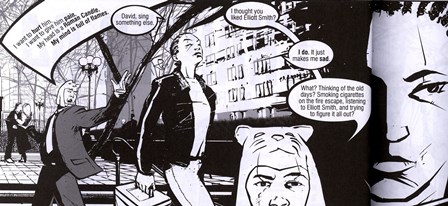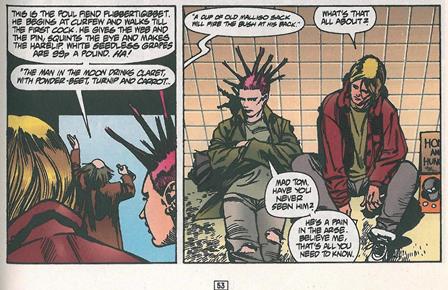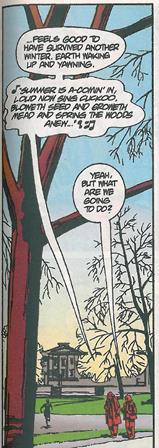In my last post, I wrote about simultaneous talk in comics, exploring the way that speech balloons can be positioned in a panel to convey a sense of overlapping talk. This post continues the series on the possibilities of simultaneous discourse. However, this one asks how visual and verbal cues might tell us something about the way readers are supposed to imagine hearing the production of both speech and song in the same panel.
The first example is drawn from Full Color, a graphic novel by Mark Haven Britt. I have taught this book a couple of times, and it is a beautifully designed comic that tells a powerful story. The main character is Boom and her best friend is David. In Figure 1, the two are walking in a park while David sings.
Figure 1.
The balloon that contains David’s song is partially obscured visually by Boom’s speech balloon. In this case, I think the example is relatively straightforward. If we follow the principle that overlapping balloons indicate overlapping discourse, then Boom’s directive (’Sing something else’) takes place during the same time that David sings.
Sometimes, the relationship between song and speech in the same panel is less clear. Two examples from Grant Morrison’s The Invisibles will help illustrate a range of possibilities. Both Figure 2 and Figure 3 come from ’Say You Want a Revolution.’ In Figure 2, we see Dane McGowan (aka Jack Frost) sitting on a sidewalk, in pretty bad shape. In the panel on the left, old Tom O’Bedlam walks by, talking in his enigmatic style. In the panel on the right, Dane/Jack’s question is rendered in a speech balloon that is separate from the others. In fact, none of the balloons even touches in this panel.
Figure 2. Dane/Jack asks about Tom.
For this post, the central question about this image is the relationship between speech and song. Is the reader expected to hear Tom’s song first, followed by (a short) silence, then followed by Dane/Jack’s turn? Or is the reader expected to hear Tom’s song take up enough time in the panel that Dane/Jack’s turn takes place simultaneously. A third possibility, of course, is that Tom’s song lasts long enough to overlap both speakers’ turns.
After some time passes, Jack and Tom become relatively stable compatriots, if not friends. In Figure 3, they are shown walking together, and Jack is trying to learn something from Tom.
Figure 3. Tom and Jack talk.
Tom speaks first and then sings, presumably with little or no silence between the end of his spoken words and the beginning of his song. In a separate speech balloon, Jack takes his own turn.
If we follow the principle that separate balloons indicate a complete separation of turns, then at no point in these two examples from The Invisibles is there overlapping discourse. However, my sense is that in some cases at least, we are encouraged to imagine the more expansive nature of song and that it is not only possible but quite likely that speakers can produce regular conversational turns that overlap the lyrics.
How do you hear music and speech in the same panel? What examples are similar to or different from those presented in this post? What other examples of song and speech have you seen mixed in the same panel? How do you imagine we should hear them? As separate? As overlapping? As complementary? As competing?



I remember talking to Gene Colan about this; he always wanted to figure out a way to represent music on a comics page. I don’t think he did, though—and the widespread practice of surrounding ballooned and italicized lyrics with little floating notes (as seen in figure 3 above) that have no relation to actual written music just doesn’t really cut it.
James, the best way to represent music on the comics page is through the affect of the listener(s) and/or performer.
I don’t have an image to hand but I think some of Joe Sacco’s Yahoo strips might be interesting here. Music (often a live band) playing, with dialogue and narration boxes, all could be happening at the same time. Another indicator may be the type of balloon. In my own strips the genre of music is sometimes indicated by the balloon, punk tunes have a jagged aggressive looking bubble, a fairly common trait I think. In such panels I always assumed the dialogue is taking place at the same time as the music, although the balloons are separate and the reader may think differently.
Poking around our music roundtable might be helpful.
Damon: I think you make a good point about style of balloon and relationship to genre of music. Are you talking about ‘Ticking Boy’ or some other strips?
Osvaldo may be right about most representations of music, but there’s a good exception in Fábio Moon and Gabriel Bá’s story ‘Happy Birthday, My Friend’ (collected in De: Tales). The characters in the story are hanging around in a bar, and the juke box is playing, but no one really seems to pay attention to it. The foregrounding of the lyrics is surprisingly effective to render it as background.
Yes Frank, I meant Ticking Boy, although the strips in question haven’t been published yet. Of course a jagged balloon could also mean electronic transmission, through speakers or a telephone for example, but that is deviating from your point a little.
Nice reminders of teqnuqie. Thanks.